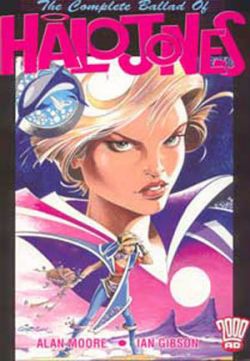The Ballad of Halo Jones
By Josh Hechinger
May 10, 2007 - 04:40
2000 AD Books
Writer(s): Alan Moore
Penciller(s): Ian Gibson
Inker(s): Ian Gibson
Letterer(s): Steve Potter, Richard Starkings
 |
| 2001 Titan Edition. Source: Wikipedia |
Writer: Alan Moore
Art: Ian Gibson
Lettering: Steve Potter and Richard Starkings
The British comic magazine 2000AD doesn’t have a reputation for being a quiet, reflective volume of sequential narrative. It’s a weekly slab of science fiction serials, full of black humor, two fisted social satire, and bang-bang shoot-‘em-up action. Put it this way: it’s the magazine where Judge Dredd once punched his fist clean through the back of a villain’s helmet.
While shouting “GAZE INTO THE FIST OF DREDD!”
Wildly fun stuff, yes. Even brilliant at times, sure.
Known for having a strong feminine viewpoint, not so much.
Alan Moore and Ian Gibson changed that, for a while at least, with their serial The Ballad of Halo Jones. And they did it by more or less ignoring the magazine’s usual fare.
Instead of being a iron-willed bastion of future-law, the titular Halo Jones was…well…normal. Never mind that she lived in the far future, in a giant metal donut tethered to Manhattan. And never mind that she was smart enough to desperately want to escape what essentially amounted to a high tech slum. You would too. That’s rather the point; she’s an Everywoman.
Her normalcy was a pivotal part of her appeal, actually. It meant that she was a far cry from the she-devils-with-big-guns, sex kitten femme fatales and damsels in distress that usually made up the female representation in comic books. She was novel.
And “novel”, in the literary sense, applies to the series as well. It’s easily one of the most well crafted serialized social/science fiction graphic novels in the medium (admittedly, this is a small field). Over the course of three “books” comprised of short episodes, Moore and Gibson run the gamut of a galaxy, exploring all the old classics: love and death, societies high and low, life in wartime and life as a war.
If Moore had chosen to do this as a prose novel, you’d have been required to read it in high school. This is Moore in top form; effortlessly weaving a narrative that’s funny and sharp and heartbreaking and as always, full of brilliant ideas.
And anyway, the school system’s loss of a classic novel is sequential art’s gain with Gibson on art chores. Over the course of the series you can watch him evolve from a highly competent artist into something approaching a true master of the medium.
As well-done as the substance of this graphic novel is, the form of it is equally impressive. Each episode of the series is roughly four to six pages long. In that limited frame, Moore and Gibson not only advance the overall plot, but frequently do so with otherwise stand-alone episodes. It’s not unlike Joseph Heller’s Catch-22; a series of vignettes and observations that come together and build momentum until the story’s a coherent machine.
The completeness of the story is surprising, considering that the series was aborted after only three of it’s intended nine books. There’s more than a few great unfinished works in comics, but Halo Jones is one of the few that doesn’t feel at all incomplete.
So, on second thought? Forget those hypothetical high schoolers from earlier; this should be required reading for anyone who enjoys seeing what the comic medium can do at it’s absolute best.
Related Articles:
The Binquirer, August 1: Waid and Yu on Hulk, Wes Craven's Coming of Rage, Alan Moore's Unearthing, and much more!
The Alan Moore Superman
Alan Moore's Light of Thy Countenance
Top Shelf Springs Alan Moore
The Mindscape of Alan Moore DVD - Essay Writing Competition
Moore Moments - A Reader Shares His Feeling About Discovering Alan Moore
Alan Moore on DVD
Alan Moore's Lost Girls
DC Prints Alan Moore Collection
Warcraft Soars; Alan Moore Needs a Nap
